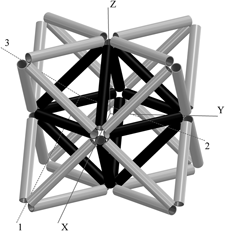Crossref Citations
This article has been cited by the following publications. This list is generated based on data provided by
Crossref.
Lehman, Jeremy
and
Lakes, Roderic S
2014.
Stiff, strong, zero thermal expansion lattices via material hierarchy.
Composite Structures,
Vol. 107,
Issue. ,
p.
654.
Ha, Chan Soo
Hestekin, Eric
Li, Jianheng
Plesha, Michael E.
and
Lakes, Roderic S.
2015.
Controllable thermal expansion of large magnitude in chiral negative Poisson's ratio lattices.
physica status solidi (b),
Vol. 252,
Issue. 7,
p.
1431.
Pasternak, Elena
Shufrin, Igor
and
Dyskin, Arcady V.
2016.
Thermal stresses in hybrid materials with auxetic inclusions.
Composite Structures,
Vol. 138,
Issue. ,
p.
313.
Ha, Chan Soo
Plesha, Michael E
and
Lakes, Roderic S
2016.
Chiral three-dimensional lattices with tunable Poisson’s ratio.
Smart Materials and Structures,
Vol. 25,
Issue. 5,
p.
054005.
Wang, Qiming
Jackson, Julie A.
Ge, Qi
Hopkins, Jonathan B.
Spadaccini, Christopher M.
and
Fang, Nicholas X.
2016.
Lightweight Mechanical Metamaterials with Tunable Negative Thermal Expansion.
Physical Review Letters,
Vol. 117,
Issue. 17,
Xu, Hang
and
Pasini, Damiano
2016.
Structurally Efficient Three-dimensional Metamaterials with Controllable Thermal Expansion.
Scientific Reports,
Vol. 6,
Issue. 1,
Xu, Hang
Farag, Amr
and
Pasini, Damiano
2017.
Multilevel hierarchy in bi-material lattices with high specific stiffness and unbounded thermal expansion.
Acta Materialia,
Vol. 134,
Issue. ,
p.
155.
Xu, Hang
Farag, Amr
and
Pasini, Damiano
2018.
Routes to program thermal expansion in three-dimensional lattice metamaterials built from tetrahedral building blocks.
Journal of the Mechanics and Physics of Solids,
Vol. 117,
Issue. ,
p.
54.
Leng, Jiazhen
Reynolds, Gerard
Schaenzer, Megan
Pham, Minh Quan
Bourgeois, Genevieve
Shanian, Ali
and
Pasini, Damiano
2018.
Stress Concentration in Low-Porosity Periodic Tessellations With Generic Patterns of Elliptical Holes Under Biaxial Strain.
Journal of Applied Mechanics,
Vol. 85,
Issue. 10,
Berger, Jonathan B.
and
McMeeking, Robert M.
2018.
Mechanical characterization of a bonded tailorable coefficient of thermal expansion lattice with near optimal performance.
Journal of Materials Research,
Vol. 33,
Issue. 20,
p.
3383.
Wang, Jingwei
Gong, Yuanyuan
Liu, Jun
Miao, Xuefei
Xu, Guizhou
Chen, Fenghua
Zhang, Qingmei
and
Xu, Feng
2018.
Balancing negative and positive thermal expansion effect in dual-phase La(Fe,Si)13/α-Fe in-situ composite with improved compressive strength.
Journal of Alloys and Compounds,
Vol. 769,
Issue. ,
p.
233.
Parsons, Ethan M.
2019.
Lightweight cellular metal composites with zero and tunable thermal expansion enabled by ultrasonic additive manufacturing: Modeling, manufacturing, and testing.
Composite Structures,
Vol. 223,
Issue. ,
p.
110656.
Zhang, Yongcun
Liang, Yujing
Yang, Zihao
Wang, Bingda
and
Liu, Shutian
2019.
A new design concept of dual-constituent sandwich panel with in-plane zero thermal expansion.
Smart Materials and Structures,
Vol. 28,
Issue. 6,
p.
065002.
Cabras, Luigi
Brun, Michele
and
Misseroni, Diego
2019.
Micro-structured medium with large isotropic negative thermal expansion.
Proceedings of the Royal Society A: Mathematical, Physical and Engineering Sciences,
Vol. 475,
Issue. 2232,
p.
20190468.
Yang, Zihao
Zhang, Yongcun
Liu, Shutian
and
Wu, Zhangming
2021.
Design and analysis of dual-constituent lattice sandwich panel with in-plane zero thermal expansion and high structural stiffness.
Mechanics of Advanced Materials and Structures,
Vol. 28,
Issue. 17,
p.
1743.
Grima-Cornish, James N.
Attard, Daphne
Evans, Kenneth E.
and
Grima, Joseph N.
2021.
Auxetic-Inspired Honeycomb Macrostructures With Anomalous Tailormade Thermal Expansion Properties Including “Negative” Heat-Shrinking Characteristics.
Frontiers in Materials,
Vol. 8,
Issue. ,
Yang, Zihao
Zhang, Yongcun
Liu, Shutian
and
Wu, Zhangming
2021.
Microstructural topology optimization for patch-based sandwich panel with desired in-plane thermal expansion and structural stiffness.
Structural and Multidisciplinary Optimization,
Vol. 64,
Issue. 2,
p.
779.
Yu, Huabin
Liang, Bo
Zhao, Zifen
Liu, Panpan
Lei, Hongshuai
Song, Weili
Chen, Mingji
and
Guo, Xiaogang
2021.
Metamaterials with a controllable thermal-mechanical stability: Mechanical designs, theoretical predictions and experimental demonstrations.
Composites Science and Technology,
Vol. 207,
Issue. ,
p.
108694.
Zhang, Keqiang
Wei, Kai
Chen, Jiaxin
Liang, Bo
Fang, Daining
and
He, Rujie
2021.
Stereolithography additive manufacturing of multi-ceramic triangle structures with tunable thermal expansion.
Journal of the European Ceramic Society,
Vol. 41,
Issue. 4,
p.
2796.
Yang, Zihao
Zhang, Yongcun
Zhang, Zonghua
and
Liu, Shutian
2022.
Buckling enhancement of tubular metamaterial with axial zero thermal expansion by integrating two adjustment mechanisms.
Materials Research Express,
Vol. 9,
Issue. 4,
p.
045801.


